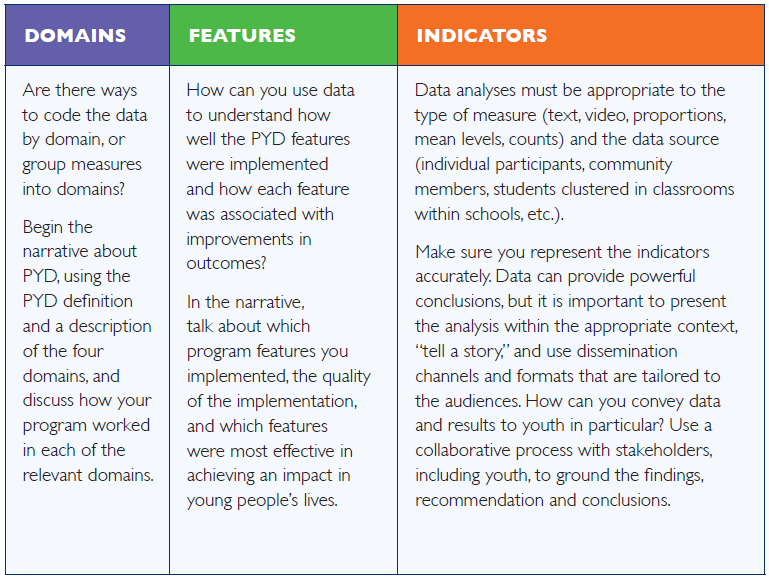Phase Five: Analyze, Disseminate and Learn From the Data
Key Questions
How will I analyze the data that I collect?
How will I learn from and communicate the PYD story from my program?
Analysis and dissemination from PYD programs, in many ways, is similar to any other program. If the program is continuing, or being implemented in other countries, then the evaluation can be used to modify and improve the project design. The evaluation should include explanations that help interpret the results and recommendations for making targeted changes to the program or future program designs.
However there are a few key differences when considering analysis and dissemination of information from PYD programs, and this section will address some of those.
PYD approaches for collaborating, learning and adapting
Collaborating, learning and adapting go hand-in-hand. Monitoring and evaluating PYD activities, outputs and short-term outcomes are critical for guiding program managers and implementers in how to improve their programs and activities. Implementers, in conjunction with funders, need to ask reflective questions when developing learning strategies about who learns and how it will be incorporated into program adaptation (see Box 2). A focus on learning is also critical for ensuring that youth programming meets the variable needs of youth and is appropriate for the environment within which they live.
Reflective questions to guide the development of learning strategies for youth programs:
• What are the program’s learning needs? (Who decides this?)
• Who needs to know what? (Who decides what is important?)
• How can information be gathered? (By whom and for whom?)
• With whom will it be shared? (Why?)
• How can/will information be used for decision-making? (Who can act on the information? How and why?)
A dissemination and utilization strategy/plan should also be included in the M&E or research plan for any PYD program.
PYD dissemination processes should involve young people. Youth advisory boards have become one method that implementing partners or researchers can use to ensure that youth are part of the data analysis and interpretation process, have input into how research results are disseminated, and facilitate modifications of program activities. Youth can also help to identify key audiences and formats for dissemination, as well as take the lead in presenting key results.
Youth participation in these activities can lead to long-term engagement in a knowledge sharing process that allows an accurate representation of the findings and alternative ideas on the dissemination methods.

Do you have more questions about the toolkit? See our Frequently Asked Questions (FAQ) section or visit the PYD glossary.












